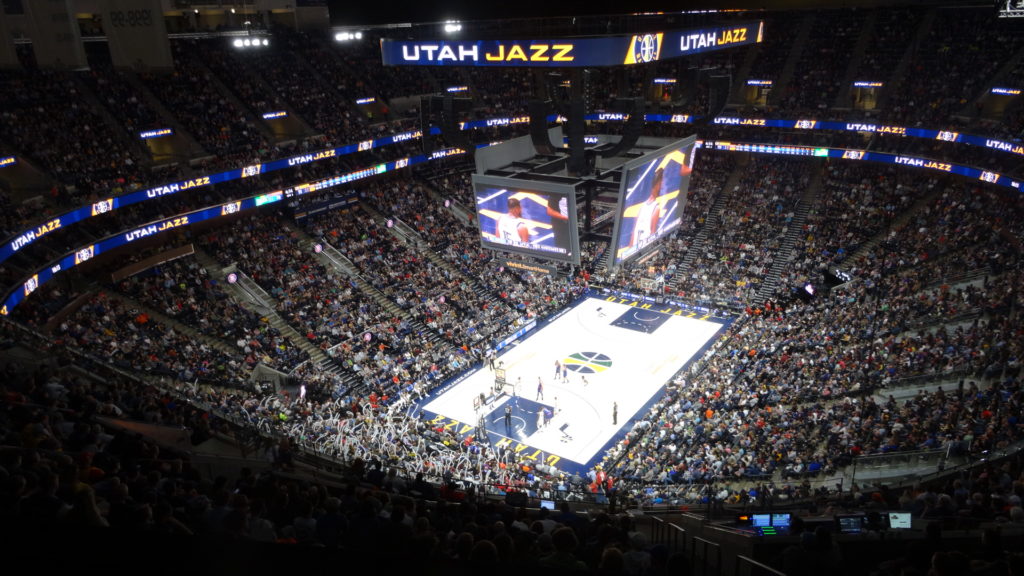At Vivint Smart Home Arena, the Utah Jazz are relishing in a new experience. The arena is providing new benefits to fans and players alike, thanks to a $125-million renovation that essentially overhauled the facility from top to bottom.
Through the renovation, which was completed prior to the 2017-18 season, the Jazz improved multiple areas of the fan experience. From the entrance, to the seats, premium areas, technology and concessions, there were multiple facets to the Vivint Smart Home Arena renovation, as the Jazz wanted to ensure that the full effects of the project were noticeable for all fans.
“We wanted to do something for everyone,” said Jamie Galileo, senior vice president of facilities for Larry H. Miller Sports & Entertainment. “From the top of the building down, we wanted to move through the building and make sure that everyone had a fantastic experience and we wanted to make sure that there wasn’t more done in one place than the other.”
To accomplish this, the Jazz undertook improvements both inside and out. On the exterior, the club improved its plaza entry by creating a 12,000 square foot atrium that includes a team store, while installing a 76-foot long outdoor videoboard. The most striking addition, however, was that of a navy, green, and gold J-note logo.
Measuring at 14-feet high by 21-feet wide, the J-note was a late addition to the project, according to Galileo, as the logo was originally going to go in the concrete. However, it has since become one of the most popular additions from the renovation; you can thank the power of selfies and Instagram for fans wanting to pose with the logo.
“One, it’s unique,” said Galieleo. “The Jazz note is kind of something you don’t see anywhere else. The second thing is that people love it, because they go over they take pictures. On the other side of the building, there are statues of Karl Malone and John Stockton. I don’t know how many thousands of people come and take pictures there, but the same types of folks now come around the front and make sure that they get a picture at that Jazz note.”
Inside, there are several notable changes. The team removed concourse walls inside the main entrance to make a porch that give fans a view of the lower bowl, while all of the green plastic seats in the arena were replaced by blue cushioned chairs. In addition, the team added the Toyota Club—a space with room for 1,700 guests that wraps around nearly two-thirds of the arena—while remodeling the WCF Insurance Club and Silicon Slopes Club.
With these changes, the Jazz did an effective job of completing improvements that help to compliment the concessions experience, which was one of the focal points of the project. The four corners of the main concourse are now home to large specialty concession areas, including BBQ from R&R, Mexican food from El Chubasco, pizza and subs from Maxwell’s, and burgers and sandwiches from Cubby’s.
While all of the stands have their own look, the four areas compliment one another by providing a unique atmosphere in the corners of the concourse, something that owes to the original design of the arena. The Jazz did not stop there, however.
“We overhauled all of the concession stands, we introduced four new restaurants on the plaza” said Galileo. “The way the building is constructed allowed for that. You have those four big corners, so we have four big restaurants partners and we’ve got nine food partners at the other concession stands. So, we went from an in-house concessions operation, to 13 local partners managed by a third-party food vendor, Levy Food Services.”
In addition, the Jazz did improve player facilities through an expanded locker room. Another notable addition was that of 2,700 solar panels that were installed on the arena roof.
One area that affected the complete experience, however, was technology, as the team added new public Wi-Fi. Since being added, the Wi-Fi has enhanced the ability for fans to engage on social media or other platforms while attending the game.
According to Galileo, the Jazz’s approach to accommodating fan’s interests when it comes to technology and social media is still evolving, but the team nonetheless sees it as a major factor in getting fans to the arena. “As far as the rest of the technology and social media, I think that’s something we’re still developing, and by developing, what do the folks want? They’re coming and doing the experience, they’re paying for and enjoying the game, what can we do to make it better for them? Because it’s all about differentiating the experience physically in the building from sitting on your couch watching the game on TV. We’re all worried about that 80-inch screen overwhelming the arena experience, and we gotta make sure that we reinforce to folks that it is different to go to the ball game.”
Vivint Smart Home Arena originally opened as the Delta Center in 1991. Galileo said that the fan feedback to the renovation has been positive, and he said that throughout the renovation process, the Jazz wanted to keep in mind the longtime connection between the fans and the arena.
“Think of it as, you have this vehicle that you grew up with. And you loved it as a kid, and you grew up with it. Well this building was 25 years old, and people have been coming here since they were young adults, small children, so they were very much in love with it. We were really worried that we just did not want to mess with the love affair.”
Ultimately, the renovations succeed as an example of how a multi-faceted approach can dramatically improve a venue and ensure that Vivint Smart Home Arena will remain viable for years to come.
This article originally appeared in the weekly Arena Digest newsletter. Are you a subscriber? Click here to sign up for the free weekly newsletter







